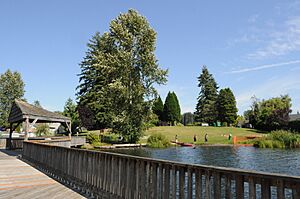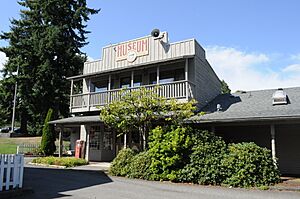Lake Stevens, Washington facts for kids
Quick facts for kids
Lake Stevens
|
|
|---|---|
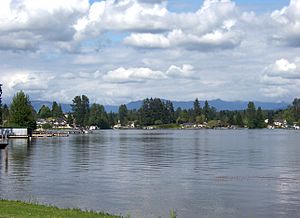
Northeast shore of lake on which the city is located
|
|
| Motto(s):
"One community, around the lake"
|
|
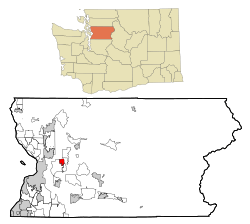
Location of Lake Stevens, Washington
|
|
| Country | United States |
| State | Washington |
| County | Snohomish |
| Founded | 1889 |
| Incorporated | November 29, 1960 |
| Government | |
| • Type | Mayor–council |
| Area | |
| • Total | 9.30 sq mi (24.09 km2) |
| • Land | 9.17 sq mi (23.74 km2) |
| • Water | 0.14 sq mi (0.35 km2) |
| Elevation | 217 ft (66 m) |
| Population
(2020)
|
|
| • Total | 35,630 |
| • Estimate
(2023)
|
40,521 |
| • Density | 3,887.2/sq mi (1,500.9/km2) |
| Time zone | UTC−8 (Pacific (PST)) |
| • Summer (DST) | UTC−7 (PDT) |
| ZIP Code |
98258
|
| Area code | 425 |
| FIPS code | 53-37900 |
| GNIS feature ID | 1512695 |
Lake Stevens is a city in Snohomish County, Washington. It's named after the big lake it sits around. The city is about 6 miles (10 km) east of Everett. It's next to Marysville on one side and Snohomish on the other. In 2020, about 35,630 people lived there.
The lake got its name in 1859 from a governor named Isaac Stevens. Long ago, the Skykomish lived in this area. The first modern town near Lake Stevens started in 1889. Later, the Rucker Brothers bought the land. They opened a large sawmill in 1907. This mill helped the town grow a lot. But it closed in 1925 after two big fires.
After the mill closed, Lake Stevens became a fun resort town. People came to relax by the lake. In the 1960s and 1970s, it changed into a place where people lived and traveled to work in other cities. Lake Stevens officially became a city in 1960. This happened after many businesses moved to a new shopping center. Since then, the city has grown by adding nearby areas. It now covers most of the lake. Its population grew four times bigger between 2000 and 2010. There are plans to make the downtown area even better in the 2020s.
Contents
History of Lake Stevens
Lake Stevens was named in 1859 after Governor Isaac Stevens. On old maps, it was called "Stevens Lake." The native Skykomish used the area to gather berries. They also hunted in the Pilchuck River basin. The first settlers came to the lake in the 1880s. Joseph William Davison started a farm there in 1886. A small town called "Outing" was planned in 1889. It was at the northeast end of the lake.
A railroad was built nearby in 1889. This helped more towns grow in the area. Towns like Machias and Hartford started up. Hartford later became an important railroad stop.
The Sawmill Era
The Rucker Brothers bought the land in 1905. They wanted to build a big sawmill. They built a special railroad track to it. Their shingle mill opened in 1907. It was one of the biggest in the United States. In 1908, they planned the town of Lake Stevens. It had homes and shops for the mill's 250 workers.
The mill was partly destroyed by a fire in 1919. It was rebuilt, but then another fire in 1925 closed it for good. Many people left the area after that. A train from the old mill sank in the lake around 1910. It was found again in 1995 by a U.S. Navy team.
From Resort to Commuter Town
By the mid-1920s, the lake's shoreline was divided into small lots. People built summer homes and resorts there. Lake Stevens became a popular resort town. About 3,000 visitors came on busy days. They enjoyed fishing, swimming, and water-skiing. Even with successful resorts, the town didn't grow much for decades.
Suburban growth started in the 1950s. A large shopping center called Frontier Village was planned. It was located west of the lake. Business owners in downtown Lake Stevens wanted to become a city. They hoped this would stop shops from moving to the new center. On November 19, 1960, people voted to make Lake Stevens a city. It officially became a city on November 29. The city government bought an old post office for its city hall.
The lake's water quality got worse because of the resorts. So, a sewer district was created in 1963. It helped manage pollution. They also put in a system to control algae growth in the lake. Frontier Village opened in 1960 and grew bigger. New highways were built, making it easier to travel. In the 1970s and 1980s, Lake Stevens became a commuter town. Many new homes were built.
Recent Growth and Changes
By the late 1990s, Lake Stevens had over 5,700 residents. It was one of the fastest-growing cities in Washington. Areas near the lake also grew a lot. Lake Stevens tried to add these areas to the city in 1993. This was part of a plan to create "one community around the lake." The first big additions happened in 2006. These included the Frontier Village area.
From 2000 to 2010, the city's population grew to almost 30,000 people. The biggest addition happened in December 2009. It added over 10,000 residents. There are plans to add more areas to the city. This will make Lake Stevens completely surround the lake.
In 2018, the city planned to update downtown Lake Stevens. They wanted to add more homes and shops. The old city hall was taken down in 2017. This was to make North Cove Park bigger. City services moved to a nearby building. A new police station is planned for the 2020s.
Geography and Nature
Lake Stevens is about 35 miles (56 km) northeast of Seattle. It's 6 miles (10 km) northeast of Everett. The city is between Marysville and Snohomish. The city covers about 9.30 square miles (24.09 km2). Most of this is land, with a small amount of water. The lake itself is not officially part of the city. But it's in the area that the city plans to grow into.
The city sits on a flat area. To the west is the Snohomish River delta. To the east are the Cascade Mountains. Lake Stevens is the biggest and deepest lake in Snohomish County. It covers about 1,040 acres (420 ha). Its average depth is 64 feet (20 m). The lake has about 7.1 miles (11.4 km) of shoreline. Several creeks feed into the lake. The lake drains into Catherine Creek, which flows to the Pilchuck River.
The lake's water quality is managed carefully. An aeration system was installed in the 1990s. This helps control phosphorus from the lake bottom. Too much phosphorus can cause unwanted algae to grow. Most of the lake's shoreline has many buildings. Not much natural plant life is left. People use Lake Stevens for fishing, swimming, boating, and skiing.
Shopping and Neighborhoods
Lake Stevens has two main shopping areas. Downtown Lake Stevens is by the lake's northeast side. It has been updated since the 1990s. Frontier Village is west of the lake. It's a typical suburban shopping center with many stores.
The city also has different neighborhoods and planning areas. These include Cavalero Hill, Frontier Village, the Hartford Industrial Area, and Machias.
Economy and Jobs
In 2018, about 15,084 people in Lake Stevens had jobs. Many people who live in Lake Stevens travel to other cities for work. About 20 percent go to Everett. Another 13 percent go to Seattle. Only about 6.3 percent of Lake Stevens residents work within the city. Most workers drive alone to their jobs.
In 2012, there were 1,553 businesses in Lake Stevens. They provided 4,202 jobs. The biggest job provider was the services sector. Education and retail also offered many jobs. The largest employer in Lake Stevens is the Lake Stevens School District. Cobalt Enterprises, an aerospace company, is also a big employer.
Hewlett-Packard opened a large factory near Lake Stevens in 1985. It made testing equipment. This factory had 1,000 employees at its busiest time. But it closed in 2002. The land was later used for new homes.
Lake Stevens has a large shopping area around Frontier Village. This shopping center started in the 1960s. It now has over 208,000 square feet (19,300 m2) of shops. A Costco store opened in December 2022. It's a big store with a gas station. The city approved this project in 2019.
Population and People
| Historical population | |||
|---|---|---|---|
| Census | Pop. | %± | |
| 1950 | 2,586 | — | |
| 1960 | 1,538 | −40.5% | |
| 1970 | 1,283 | −16.6% | |
| 1980 | 1,660 | 29.4% | |
| 1990 | 3,380 | 103.6% | |
| 2000 | 6,361 | 88.2% | |
| 2010 | 28,069 | 341.3% | |
| 2020 | 35,630 | 26.9% | |
| 2023 (est.) | 40,521 | 44.4% | |
| U.S. Decennial Census | |||
Lake Stevens is the sixth-largest city in Snohomish County. In 2020, its population was 35,630. It has been the fastest-growing city in the county since 2000. Its population grew by 18 percent from 2010 to 2018. This was due to new homes and adding more areas to the city.
Population in 2010
In 2010, there were 28,069 people living in Lake Stevens. There were 9,810 households. About 45.1% of households had children under 18. Most people (85.1%) were White. About 8.6% of the population was Hispanic or Latino.
The average age in the city was 32.5 years. About 29.9% of residents were under 18. The number of males and females was almost equal.
City Government
Lake Stevens has a mayor–council system. This means there is a mayor and a city council. The city council has seven members. They are elected by the people for four-year terms. The council meets twice a month. The mayor is also elected for a four-year term. The current mayor is Brett Gailey.
The city government had a budget of about $50.4 million in 2020. It gets money from sales, property, and utility taxes. The city has 85 employees. They work in different departments like economic development, finance, parks and recreation, and policing.
Lake Stevens also has several groups of volunteer citizens. These groups advise the city council on different topics. They help with things like arts, parks, and planning.
Political Representation
At the national level, Lake Stevens is part of the 1st congressional district. This district is represented by Democrat Suzan DelBene. At the state level, Lake Stevens is in the 39th legislative district. This district also includes towns like Darrington and Granite Falls.
Culture and Fun
Lake Stevens has a yearly summer festival called Aquafest. It happens at North Cove Park in downtown Lake Stevens. It's a three-day event in late July. Aquafest started in 1960. It includes a boat parade, carnival rides, a car show, and a circus. In 2018, about 30,000 people went to the festival.
An annual Ironman 70.3 triathlon was added to Aquafest. It's a long race with swimming, biking, and running. This triathlon helps people qualify for the Ironman World Championship.
Parks and Outdoor Activities

Lake Stevens has 195 acres (79 ha) of parks and open spaces. These are managed by the city, Snohomish County, and the state. The city owns 158 acres (64 ha) and has nine parks. There are also private parks owned by homeowner groups.
Eagle Ridge Community Park is the largest city park. It's 28 acres (11 ha) near the lake. Snohomish County has three parks in the area. Cavalero Community Park has two fenced dog parks. Lake Stevens Community Park has soccer and baseball fields. Davies Beach has a beach, a boat launch, and a boathouse.
Several city parks are along the shore of Lake Stevens. They have beaches for swimming and fishing docks. Lundeen Park is the biggest beach park. It used to be a resort. You can rent paddleboards and kayaks there. North Cove Park in downtown is being developed into a community gathering place. A disc golf course opened in 2000 at Catherine Creek Park.
The Centennial Trail is a long path for hiking, biking, and horseback riding. It goes through the east side of Lake Stevens. The city also has shorter trails. Lake Stevens plans to connect these trails into a bigger network. The city also has a community center. Several local rowing clubs use Lake Stevens.
Preserving History
The local historical society used to have a museum next to the city library. It opened in 1989. The museum had old items, documents, and photos. The Grimm House was also on the museum grounds. It's a historic house built in 1903. It was moved to the museum in 1996.
The museum was closed and taken down in June 2017. This was part of the North Cove Park update. The Grimm House was moved to a new spot.
Notable People
- Travis Bracht, singer
- Jacob Eason, professional American football player
- Cory Kennedy, professional skateboarder
- Kathryn Holloway, Paralympic volleyball player
- Chris Pratt, actor
- Karla Wilson, politician
Education and Learning
The Lake Stevens School District runs the public schools in the city. It also covers parts of nearby Marysville. In 2016, about 8,838 students were in the district. There was one high school, Lake Stevens High School. It opened its current campus in 1979. It was updated starting in 2018. The first part of the renovation opened in November 2019.
The school district also has one mid-high school (for grades 8–9). It has two middle schools and seven elementary schools. The newest elementary school, Stevens Creek, opened in 2018.
The closest colleges are Everett Community College and Edmonds College. Lake Stevens was considered for a new branch campus of the University of Washington (UW) in the late 2000s. But the project was stopped in 2008.
Library Services
The first public library in Lake Stevens opened in 1946. It was in a local resident's home. It moved to an old post office in 1949. In 1985, the city moved the library to a former pharmacy. It then joined Sno-Isle Libraries, a larger library system.
The downtown library building was small. It was decided that a new, bigger library was needed. Sno-Isle suggested a larger library as part of a new city center. This would cost $17 million. Voters approved the money in February 2017. However, it didn't get enough votes to pass. A second try in February 2018 also failed.
The old library was taken down in June 2021. This was part of the North Cove Park updates. A temporary library opened at Lundeen Park. Sno-Isle moved into a renovated police station in August 2021. In January 2022, the city thought about leaving the Sno-Isle system. But this idea was soon dropped. Sno-Isle announced plans for a permanent library building. They received $3.1 million in state money. Work on the new library site began in March 2023. The new two-story library building is planned to start construction in 2025. It will be 15,000 square feet (1,400 m2).
City Services
Getting Around
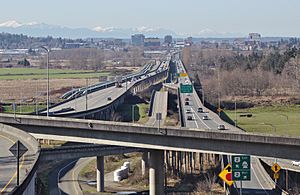
Three state highways go through Lake Stevens. State Route 9 runs north and south. State Route 92 goes northeast. State Route 204 connects to U.S. Route 2. In 2023, several roundabouts were built at the intersection of State Route 9 and State Route 204. The Hewitt Avenue Trestle carries US 2 to Everett. It often has traffic jams.
Community Transit runs bus routes in Snohomish County. Buses from Lake Stevens go to Everett, Granite Falls, Lynnwood, Marysville, and Snohomish. The city has a small park and ride lot. It opened in 2004. Community Transit also has a Zip Shuttle service. It expanded to Lake Stevens in December 2024.
Utilities and Services
The Snohomish County Public Utility District (PUD) provides electricity and water. The water comes from the City of Everett system. Natural gas is provided by Puget Sound Energy.
The city works with Republic Services and Waste Management. They collect garbage, recycling, and yard waste. The Lake Stevens Sewer District manages the city's sewer system. It built a new treatment plant in 2013. The sewer district is planned to join the city government in 2032.
Healthcare Access
Lake Stevens has two urgent care centers. These clinics provide medical services. One is a branch of The Everett Clinic. The other is a MultiCare Indigo Urgent Care Clinic. It opened in 2017.
See also
 In Spanish: Lake Stevens (Washington) para niños
In Spanish: Lake Stevens (Washington) para niños


